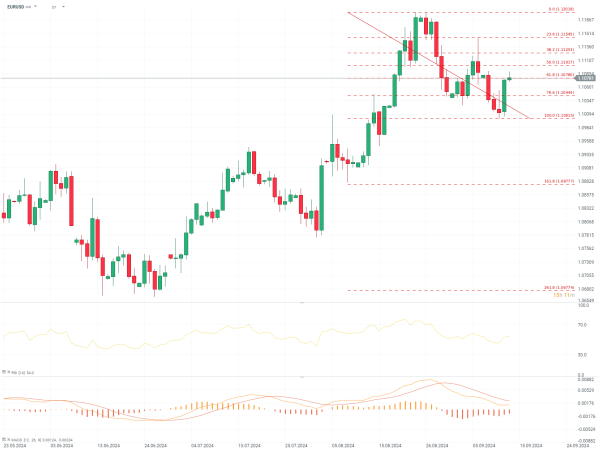Chart of the day - EURUSD (13.09.2024)
The Eurozone and United States show contrasting economic indicators, with the ECB initiating rate cuts while market expectations point to potentially faster and larger cuts from the Fed. This divergence in monetary policy outlooks could significantly impact the EUR/USD pair in the coming months.
The European Central Bank (ECB) has cut its key interest rates by 25 basis points, with the deposit facility rate now at 3.50%. This decision comes as the Eurozone's consumer price index (CPI) rose by 2.2% year-on-year in August, nearing the ECB's 2% target. Meanwhile, the U.S. consumer price index increased by 0.3% month-over-month in August, exceeding the expected 0.2% rise. These figures underscore the contrasting economic conditions in the two regions, with Europe focusing on stimulating growth while the U.S. continues to combat inflationary pressures.
A key factor in the ECB's decision was the persistent weakness in Eurozone economic growth. The region's GDP grew by just 0.2% in Q2 2024, revised down from an initial estimate of 0.3%. Germany, the largest economy in the bloc, contracted by 0.1%. In contrast, the U.S. economy has shown more resilience, with the labor market remaining tight and consumer spending robust, despite the Fed's aggressive rate hikes over the past year.
Market anticipates faster Fed rate cuts, potentially boosting EUR/USD
While the ECB has already begun its easing cycle, market participants increasingly believe that the Federal Reserve will need to cut rates faster and more aggressively than previously anticipated. This shift in expectations is driven by several factors:
- Former New York Federal Reserve President Bill Dudley has argued for a 50 basis point cut, stating that current rates are 150-200 basis points above the neutral rate.
- Recent U.S. economic data, including disappointing job openings figures, have supported the case for more substantial rate cuts.
- The persistent strength of the U.S. dollar has raised concerns about its impact on U.S. exports and global financial stability.
Analysts now forecast that the Fed could cut rates by up to 125 basis points by the end of 2024, potentially bringing the federal funds rate to between 4.0% and 4.25%. This is a more aggressive easing path than what is currently expected for the ECB, which is projected to lower its main interest rate to 3.5% over the same period.
The anticipation of faster and larger rate cuts by the Fed could have significant implications for the EUR/USD pair:
- Dollar weakness: Expectations of more aggressive Fed easing could lead to a weakening of the U.S. dollar, potentially pushing the EUR/USD pair higher.
- Yield differential narrowing: As the Fed is expected to cut rates more rapidly than the ECB, the interest rate differential between the two currencies could narrow, making the euro relatively more attractive.
Despite these expectations, it's important to note that actual policy decisions will remain data-dependent. The Fed's approach to rate cuts will be influenced by incoming economic data, particularly inflation and employment figures. Any surprises in these indicators could lead to rapid shifts in market expectations and, consequently, in the EUR/USD exchange rate.
Looking ahead, the EUR/USD pair's trajectory will likely be shaped by how these diverging monetary policy expectations unfold. While the market currently anticipates faster Fed cuts, the actual pace and magnitude of easing by both central banks will be crucial in determining the pair's direction. Traders and investors will need to closely monitor economic data releases and central bank communications for signs of any shifts in policy stances.
EURUSD (D1 interval)
EUR/USD is currently attempting to stay above resistance at the 61.8% Fibonacci retracement level, gaining today on the increased likelihood of a 50 bps rate cut. The pair has been in a downtrend over the past month, characterized by lower highs and lower lows. The RSI, currently in neutral territory, is showing signs of bearish divergence, with lower lows and lower highs. The MACD is indicating weakening growth potential. For bears to regain control, the 78.6% Fibonacci retracement support at 1.10444 must be broken. This level acted as strong support two weeks ago and successfully held for five consecutive sessions, helping to create subsequent bullish momentum. For bulls to regain control, last week's high at 1.11082 must be breached. A successful close above this level would signal the end of the current downtrend.
 Source: xStation
Source: xStation